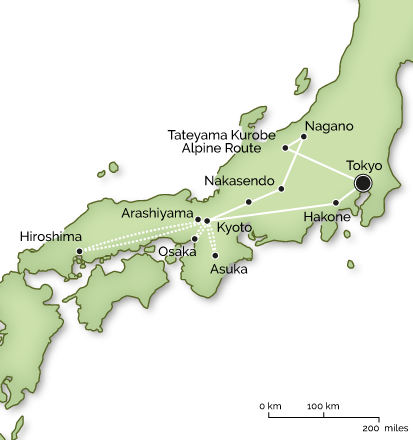JAPAN FAMILY ADVENTURE HOLIDAY
Sumos & Samurai
Prepare to step into a Dahl-like fairy-tale on this 14-night tour of Japan, an ancient culture of fierce samurais, emperors and shoguns set alongside gentle geishas, temples and Zen gardens.
Your adventure will begin in the high octane-city of Tokyo; explore giant techno stores, vibrant anime characters and Shinto shrines or learn how to make classic sushi. Next, head into the Hakone Mountains, home to volcanic virtuosity, hot spring onsens and Mount Fuji before hopping on a bullet train to the historic city of Kyoto to immerse yourself in spiritual temples, traditional tea ceremonies and beautifully laid-out forest trails.
From your base in Kyoto, enjoy day trips to Osaka, the street-food hub whose digital neighbourhoods feel like a real-life video game or Asuka the cycling haven with its stone monoliths and emerald green rice paddies. Continuing west, explore the sombre, sacred ground of Hiroshima and Miyajima Island with its inquisitive deer and floating torii gates. Spend your final few days walking the ancient Nakasendo Trail and witnessing the meditative, spa-loving snow monkeys at Jigokudani Monkey Park.





What's included
- Flights: International return flights from UK to Tokyo (HND or NRT)
- Transport: 14-day Japan Rail Pass or 14-day car hire
- Activity Passes: Hakone 2-Day Pass, Snow Monkey Pass
- Accommodation: 14 nights in characterful hotels, apartments and traditional ryokans
- Meals: Breakfasts & dinners where stated
- Trip Pack: Key family-friendly information about the country you are visiting with recommended activity links, places to eat, travel blogs and fun facts.
Trip highlights
- Explore modern and ancient Tokyo
- Ride the Hakone ropeway then relax in the soothing waters of an onsen with views of Mount Fuji
- Stay in a traditional ryokan with authentic Japanese food
- Experience Zen gardens, temples and geishas in Kyoto
- Learn about Japan’s history at the Hiroshima Peace Park
- Watch wild snow monkeys bathe in hot springs near Nagano, and encounter fearless deer in the manicured gardens of Nara Park
- Seize to opportunity to learn calligraphy, ninja training, sushi making or traditional meditation
Key facts
- When can we go? All year round
- What type of tour is it? Private self-guided family tour
- Who is it suitable for? For big city addicts, anime & manga enthusiasts, ancient traditions seekers, alpine hikers and volcanic landscape lovers
- What is the minimum age? We would recommend a minimum age of 7 years for this trip but this is just a guide - our itineraries can be adapted, no problem, for families with younger children
Guide price
We publish ‘guideline prices’ for both the high and low season to give a reasonable estimate of what you might expect to pay per person based on a family of four (two adults, two children) - to get an accurate price based on your estimated departure date and party size please contact us directly
Guide Price: Jan to Dec - £2,598 pp
Japan Adventure Holiday - Trip Itinerary
Touch down in Tokyo, Japan’s futuristic capital and its most animated city. From cat cafes to Sumo museums to quick-slurped noodles, there are endless sights to uncover in this city of contrasts.
After settling in to your accommodation, we would recommend heading out to explore the city. Harajuku is the ‘spiritual home’ of Japan’s unique pop culture and a great introduction to the city. Take a stroll through the leafy forest to the Meiji shrine, a popular venue for traditional Shinto weddings. After paying your respects, walk through the grounds to the teahouse and azalea garden. Afterwards, head down the hill to Takeshita Dori, a street of boutiques famous for their bizarre items. The nearby, Omotesando Boulevard, is Tokyo’s equivalent to the Champs-Élysées.
Just down the road, the ‘Shibuya Scramble’, a crowded intersection and a famous symbol of urban Japan is an experience in itself. The small statue of a dog named Hachiko is also located here and is the meeting hub for the city’s youth. If you would prefer to take in Tokyo’s skyline, we would recommend heading up the Tokyo Metropolitan Government Building to witness incredible city views.
Tokyo will be the base for your first four nights.
Fun Facts: In the 1920’s, Hachiko waited at Shibuya train station every day for his master to return home from work. When his owner died, Hachiko continued to come to the station every day for 9 years to wait for him. The statue acts as a symbol of Japanese loyalty and companionship.
Optional Activities: Tokyo Metropolitan Government Building (free)
This morning, you have the option of experiencing the hustle and bustle of the world-famous Tsukiji Fish Market - walk the pedestrian alleys lined with everything from wagu beef to matcha ice cream before watching men with hooks slice at giant frozen tuna, like medieval artisans carving pink alabaster pillars. You might also like to learn the fine art of sushi-making under the guidance of a master.
It is just a short walk from Tsukiji Fish Market to the nearby gardens showcasing seasonal blooms, tidal ponds and Instagram-worthy bridges. The picturesque tea house is the perfect stop for a cup of green tea, or matcha. From here, it is a short hop on the subway to the Imperial Palace, the primary residence of the Emperor of Japan. We would recommend following the beautifully laid-out forest trails that lead to tiny purification booths where you can make a wish for the spirits to answer. A short walk away is also the National Museum of Modern Art where you can browse the galleries for kimonos, lacquerware and glassware.
In the evening, you could learn the ancient art of samurai with a short sword demonstration in Tokyo’s Samurai Museum. The museum not only exhibits samurai swords, armour and guns, but also allows visitors to participate by trying on samurai outfits and having a go themselves. Alternatively, you might like to learn about Japan’s rich culinary heritage on a local food tour. Duck down Yakitori Alley to sample bamboo-skewered meat and vegetable appetizers, munch on mochi in Ginza then hop on a Tokyo Metro to Tsukishima to try Monja-yaki, a traditional pancake made with cabbage, mochi and pork.
Fun Facts: In 2017, at the traditional New Year auction, a wealthy restaurant owner paid more than £500,000 to snap up a 210kg Pacific bluefin tuna at Tsukiji Fish Market.
Optional Activities: Tsukiji fish market, National Museum of Modern Art, Samurai Museum, food tour
This morning we would recommend visiting a sumo stable to see sumo wrestlers taking part in morning practice. Depending on the time of year, it may also be possible to watch a sumo tournament. Afterwards, we would recommend heading north to the Sumo Museum to learn more about this traditional art form. The Edo Tokyo Museum next door is a veritable goldmine with its recreations of old Edo houses and dioramas and a great place to spend an hour or so.
In the afternoon, we would suggest travelling to nearby Asakusa to visit the Sensō-Ji temple, an ancient Buddhist temple. Afterwards, explore the charming streets of Asakusa, an area that possesses the atmosphere of an old Tokyo with traditional craft shops and sizzling street-food stands. Your final stop for the day should be Akihabara, Japan’s ‘electric town’. Here you will find outlets specializing in manga and anime while staff dressed as butlers serve tea at nearby ‘maid’ cafes.
In the evening, there are fabulous character restaurants with Pokemon-like players and homage to Hello Kitty. Tokyo's high-end department stores are also a foodie paradise with an amazing selection of beautiful patisserie, fabulous bento boxes and sushi. Alternatively, you could visit the ‘Sky Tree’, a huge 350m tower in the heart of the city with panoramic city views.
Fun Facts: Sumo wrestlers are required to live in sumo training stables. They must dress in traditional Japanese clothing at all times with every aspect of their life dictated by strict rules.
Optional Activities: Sumo training, sumo tournament, Edo Tokyo Museum, Tokyo Sky Tree
There are a variety of family-friendly options to keep you busy today. For families with younger children, we would recommend a trip to Tokyo Disney or Disney Sea, two theme parks, set side-by-side. Also located to the south of the city is Odaiba, reached by subway or at a more relaxed pace on a cruise down the Sumida River. There are lots of fun family things to do in Odaiba such as the trick art museum and the Lego Discovery Center. There is also the National Museum of Emerging Science and Innovation, or Miraikan, where you can learn about the impacts of climate change as well as seeing rapidly developing robot technology in action.
To the west of the city centre is the Ghibli Museum, which showcases the work of the Japanese animation studio ‘Studio Ghibli’. It is a magical, enchanting experience that relays the art and science behind animation. It also details the inspired life of Hayao Miyazaki, the creator of some of Japan’s most famous animated movies of all time.
If you would prefer to venture further out of the city, we would recommend travelling to Nikko National Park and the lavish Toshogu Shrine. Now a UNESCO World Heritage Site, the buildings here are some of the most beautiful in Japan, set within a large park including plateaus, waterfalls, lakes, forests and rivers.
Fun Facts: Studio Ghibli is behind some of Japan’s most beloved animated films, such as “My Neighbor Totoro”, “Princess Mononoke”, “Spirited Away” and “Ponyo”.
Optional Activities: Tokyo Disneyland/Disney Sea, Ghibli Museum, Trick Art Museum, Lego Discovery Center, Miraikan
Just an hour from Tokyo but a world apart, lies Fuji-Hakone-Izu National Park, home to spectacular lakes, forests and sweeping views of the snow-capped symmetrical cone of Mount Fuji. This national park is perfect for families with some of the best views witnessed from easily accessible cable cars, mountains railways and a pirate ship that crisscrosses the area. You will be provided with a ‘Hakone Pass’ that covers transportation and entrance to the main sights in the area.
For active families, we would recommend following the dappled old forest trail road until you reach the 17th-century teahouse, where you can refuel with some traditional tea. Afterwards, there is the opportunity to bathe your tired muscles in a steamy onsen, whose mineral rich waters stream from a natural hot spring and boast therapeutic qualities.
For the next two nights, you’ll stay in a ryokan, a traditional Japanese inn complete with sliding doors, tatami mat floors, futon bedding, green tea and home-cooked Japanese food.
Fun Facts: Mount Fuji is actually a stratovolcano, three separate volcanoes placed on top of one another. The bottom layer is the Komitake volcano, then the Kofuji volcano, then Fuji, which is the youngest.
Included Activities: Hakone Pass - unlimited use of buses, trains, boats, cable cars and ropeways in the Hakone area
Optional Activities: Old Tokaido forest trail, onsen
This morning, hop on the Tozan switchback train that zigzags through the mountains before taking the Guinness World Record ropeway up to Mt Owakudani with fabulous views of the volcanic valley below. After descending back to ground level climb aboard a replica pirate ship to explore Lake Ashinoko’s clear blue waters with its unforgettable view of the famous Mount Fuji. Afterwards, we would recommend following the lantern lined path that leads through the forest to the Shinto shrine and the floating Torii Gate.
In the afternoon, we would suggest checking out the local museums. Our favourites? The Open-Air Museum with its quirky assortment of Jenga style wooden sculptures surrounded by beautiful forested mountains or the Museum of The Little Prince – the world’s only gallery dedicated to the novel by Antoine de Saint-Exupéry. If you would prefer a little more adventure, there are a few local companies that offer half-day cycle tours around the Lake Ashi area.
Fun Facts: Owakudani is famous for its black eggs and eating one is said to prolong a life by 7 years! The eggs are boiled in the hot springs and turn black after cooking due to the minerals in the water.
Included Activities: Hakone Pass - unlimited use of buses, trains, boats, cable cars and ropeways in the Hakone area
Optional Activities: Open-Air Museum, Museum of The Little Prince, cycling tour
The elegant Shinkansen or ‘bullet train’ will whisk you from Hakone to Kyoto, Japan’s celebrated cultural capital. It is a city where quaint streets, Buddhist temples, geisha and ninja heritage, kaiseki cuisine and delicate paper lanterns create a distinctive atmosphere of Old Japan.
We would recommend starting your stay in Kyoto with a visit to the major Shinto complex located in the pretty wooded hills. Walk under thousands of beautiful vermilion gates that open onto dappled walking trails around Mount Inari. Afterwards, you might like to head to the local sake museum to learn about the craftsmanship that goes into each bottle of this beloved Japanese spirit or continue on to a paper lantern studio to try your hand at making a traditional paper lantern to carry home as a souvenir.
Later in the afternoon, we would recommend visiting the manga museum and its collection of some 300,000 comics. Grab one from a towering bookcase and hunker down with a coffee in the museum's wood-decked outdoor café. You could also observe the process of creating manga artwork or join in a creative workshop to realise your own manga masterpiece.
In the evening, the Gion Corner Theatre is an absolute must to witness a show of traditional Japanese performance including real geisha performing their classical arts.
Fun Facts: In the old times, geisha had black teeth for means of beauty.
Optional Activities: Gekkeikan Okura Sake Museum, paper lantern workshop, International Manga Museum, Gion Corner theatre
We would recommend starting your day visiting the breath-taking Golden Pavilion. Nothing is as symbolic of Kyoto as Kinkaku-ji's golden reflection shimmering across the rippled surface of the pond before it. The nearby teahouse is a great place for morning snacks.
Afterwards, head west to Arashiyama and the famous bamboo forest. Meander through 14th-century gardens scattered with temples and shrines which have remained pristine despite savage wars and historical dramas. Nearby you can visit the Japanese macaque monkey reserve on Mount Arashiyama, with its stunning views over the city.
To complete your day, we would suggest taking the scenic railway to the river where you can board a traditional riverboat for a scenic two-hour ride through the lush, rural landscape.
Fun Facts: Bamboo is the fastest growing plant on the planet. It can grow 3 feet in height in 24 hours under appropriate climate conditions.
Optional Activities: Scenic railway, river cruise
After breakfast, you might like to join a traditional meditation class. Discover your inner peace with a Zen Buddhist monk who will take you on a journey of serenity. Alternatively, you might like to experience Japanese culture with a calligraphy lesson led by a master of calligraphy or channel your inner ninja in a hands-on introduction to Japanese combat.
Spend the remainder of your day in Kyoto’s Higashiyama district. Follow the canal-side Philosopher’s path with its picturesque bridges and moss-covered shrines. A 10-minute walk from the end of the path is the Yasaka shrine, one of the most historic shrines in Kyoto. Nearby, is the wonderfully atmospheric Southern Higashiyama with its narrow streets and wooden buildings. From here, it is a short walk to two of Kyoto’s top temples, where families can make wishes for health, love, or success.
If the above itinerary is a little too temple-centric we would suggest visiting Nishiki Market, a foodie heaven where you can join a food tour or Nijo castle built in the 17th century for the shogun Tokugawa Ieyasu, who is said to have unified modern Japan. Inside the castle grounds, the main attraction is the palace with its beautiful nightingale floor and cherry gardens. To make things a little more memorable you could also rent a kimono for the day.
Dusk shows Kyoto at its best. Wander through the charming Pontocho Alley, crammed with dimly-lit lanterns and intimate wood-panelled restaurants making it the perfect spot for dinner. As evening falls, indulge in one of Japan’s favourite past-times as you become acquainted with the karaoke bars of Kyoto, many of which are family-friendly.
Fun Facts: Many samurai were trained in ninjutsu – the skills of the ninja.
Optional Activities: Meditation session, calligraphy workshop, ninja training, Kyoto Railway Museum, Nijo castle, karaoke
This morning, catch a bullet train from Kyoto to Hiroshima, a journey time of around 1 hr 40 mins. It would be impossible to visit the revived city of Hiroshima without confronting its tragic past, entirely defined by the events of 6 August 1945, when the city was largely destroyed by an atomic bomb. The shattered dome above which the A-bomb detonated still stands within the Peace Memorial Park. The accompanying museum pulls no punches with its graphic displays so please consider whether it would be suitable for your family.
After visiting Peace Park, we would suggest making your way to the scenic island of Miyajima, a UNESCO world heritage site and home to the iconic Great Torii floating shrine. There are opportunities to kayak through the serene island waters and feed the deer before sampling the excellent oysters that this region is famed for. You could also board the cable car to the top of Mt Misen for fabulous views or visit the wonderful aquarium showcasing otters, sharks and moon jellyfish. If you head inland, through the verdant gardens, you will find temples with sonorous tolling bells and dozens of smiling buddhas wearing jaunty knitted hats and bibs.
In the evening, you might like to seek out the savoury pancake okonomiyaki, a signature Hiroshima dish, before hopping back on the train to your base in Kyoto.
Fun Facts: Miyajima is Japanese for "shrine island".
Optional Activities: Hiroshima Peace Memorial Museum, kayaking, Miyajima Public Aquarium
Today you have the option of visiting either Osaka or Asuka & Nara. Asuka & Nara would be much more rural with Osaka another big city trip.
It is just a 1-hour train journey from Kyoto to Osaka, a fiercely spirited city cloaked in dazzling neon billboards. We would recommend starting your day at Osaka Castle where you can check out the nine-level castle keep or “donjon”. Next, head to the wacky world of Shinsekai, whose colourful over-the-top signage, is overwhelming even by Japanese standards. From Shinsekai, it is a pleasant 25-minute walk to Shinsaibashi, Osaka top shopping destination. To get the most out of your time in Osaka we would recommend joining a guided food tour run by a local.
If you would prefer to explore the countryside then we would recommend heading to Asuka, Japan's first permanent capital and an area of rolling green hills and terraced rice paddies. We would suggest renting bicycles to check out impressive megaliths, tombs, temples and tortoise stones. In the afternoon, you might like to join a farming tour to help plant & harvest seasonal organic vegetables. Afterwards, enjoy lunch with the farmers. On your return journey, stop at Nara and make your way to Nara Park, renowned for its free-roaming deer who are a symbol of the city. Street vendors located throughout the park sell deer crackers or Shika senbei, perfect for the kids to feed them.
Fun Facts: Nara's deer are actually divided into two types based on their diet: "park deer," who reside in the flat lands of Nara Park, and "Mount Wakakusa deer".
Optional Activities: Osaka free walking tour, street food tour, cycle hire, Asuka farm experience, Asuka grape farm
Today make your way to the train station in Kyoto and north-east to the town of Nakatsugawa. It is a short bus journey from here to the start of the Magome-Tsumago section of the Nakasendo trail. The Nakasendo was one of Japan’s ancient highways running between Edo (Tokyo) and Kyoto and dates back to a time when feudal lords, samurai and geisha roamed the streets.
The 2-3 hour walk between the beautifully preserved Edo-period post towns of Magome and Tsumago, reveals ancient shrines, stunning cedar forest, tumbling waterfalls, bamboo groves, terraced rice paddies and a teahouse rest stop. In autumn, orange persimmons, vibrant as paper lanterns, hang to dry in rows under eaves. Every half a mile or so little bells attached to posts, beg to be rung to warn bears of your passing.
Spend a relaxing evening in Magome where you can hunt out the best gohei mochi, a toasted rice balls covered in sweet walnut-miso paste, chestnut-flavoured ice cream and slurptastic soba noodles.
Fun Facts: The name “Nakasendo” literally means mountain road, and was historically less popular than the coastal road “Tokaido”.
This morning travel back to the train station in Nakatsugawa and onwards to the city of Nagano. After dropping off your bags, it is time to hop on the bus to Jigokudani Monkey Park, nestled at the foot of the Shiga Highlands in the Valley of Yokoyu. The famed Snow Monkey Park is a 30 minutes hike along a pretty forest trail and is the only place in the world where you can see wild snow monkeys bathing in natural hot springs. Despite their wintry moniker, the monkeys can be found bathing in the pool all year round.
After visiting the park, we would recommend taking the short bus ride to Shibu Onsen, a small town that is lovely to explore on foot, and where you can visit one of the local hot springs yourselves. There are 10 springs, each to be enjoyed for their subtle differences in quality, colour and scent.
Spend your final two nights in Nagano.
Fun Facts: Kurobe Dam is the highest (elevation: 1,454 meters), the tallest (454 meters), and probably the most dangerous dam (171 construction-related deaths) built in Japan.
Included Activities: Snow Monkey Pass - unlimited use of Nagano Dentetsu Train Line, Nagaden Express bus, Nagaden local bus, admission to the Snow Monkey Park
Optional Activities: Shibu Onsen hot springs
Your final day is either free to relax and enjoy the local temples and hot springs or for those still craving adventure, we would recommend the Tateyama Kurobe Alpine Route. It is a long day of travel from Nagano but definitely worth it for the spectacular mountain scenery.
Crossing the Tateyama Kurobe Alpine Route, also known as the “Roof of Japan”, involves a combination of trains, cable cars, trolley-buses and ropeways. Along the way, you will get a chance to visit the Kurobe Dam, the Daikonbo viewing platform, the stunning Murodo highlands and the Midagahara wetlands. There are a variety of family friendly hiking trails to choose from all with stunning views of snow-capped mountains, lush valleys and shimmering turquoise lakes.
After completing the route, head back to Nagano for your final evening.
Fun Facts: Kurobe Dam is the highest (elevation: 1,454 meters), the tallest (454 meters), and probably the most dangerous dam (171 construction-related deaths) built in Japan.
Optional Activities: Tateyama Kurobe Alpine Route
It is time to catch your train back to Tokyo for your return flight to the UK. Travel home with a bagful of stories to share around the dinner table.
Wandering Tribe has travelled to all of the destinations that we feature and we like nothing better than talking about them. If you would like further information about these tours or a tailor-made quote then please contact us on 07392 742333. Alternatively you can fill in the contact form and we will endeavour to get back to you as soon as possible.
